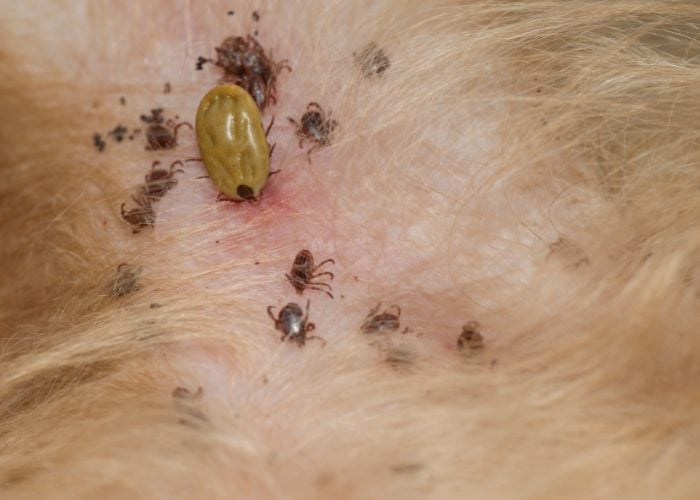Folliculitis in Dogs: 5 Causes and How to Treat Them
Identifying Folliculitis in Dogs
Whatever the cause of the inflammation may be, the principal and most noticeable symptoms of canine folliculitis can be:
- Swelling
- Redness
- Itching
- Pustules (Pimples)
- Hair Loss
But you can also check for:
- Hyperpigmentation, or darkening of the skin;
- Superficial Erosions, or the loss of the outer layer of the skin, causing raw spots on the skin;
- Draining Tacts or Fistulous Tracts are large, firm, raised, and damaged circular tissues in between your dog's skin;
- Papules are solid and elevated reddish swellings on the skin caused by inflammation;
- Epidermal Collarettes are circular areas of hair loss paired with crusting or scaling around their borders.
Aside from these symptoms, your dog's veterinarian will also do several diagnostic tests such as skin scrapings, skin cytology, and fungal culture to determine whether they have Canine Folliculitis or not.
Other possible tests also include ringworm testing, skin biopsy, histopathology, and bacterial culture and sensitivity.
There are no specific breeds predisposed to having a hair follicle infection. However, some dog breeds can have skin diseases in general.
They may also contract systematic diseases, like canine skin infection, that can eventually lead to folliculitis.
Causes and Treatments of Folliculitis in Dogs
The most common causes of folliculitis in dogs are skin diseases
. Skin diseases originate from an overreactive immune system response to allergies or specific infectious or environmental agents.
As dogs instinctively scratch their skin, they will also produce tiny skin wounds that become infected with bacteria, leading to folliculitis or staph infection.
The nine most common skin conditions that may cause folliculitis in dogs, as well as proper treatment for them, are:

1. Callus Dermatitis
When a dog scratches and bites an affected area, it can create cracks in the skin. These cracks also provide warm, dark, and moist regions that encourage bacterial growth.
Constant irritation forms calluses, most often found on their feet but may also be found on the chest, elbows, and hocks.
A callus may be possible protection of the skin.
Still, where calluses reside, there can be the formation of small cysts around the hair follicles that may become irritated and cause bumps, blackheads, holes, or discharge on the callus.
Treatment: Vet diagnosis, antibiotics, and medicated shampoo for two to six weeks. Use soft bedding and maintain the dog at a healthy weight to reduce pressure placed upon the calluses.

2. External Parasites
Fleas are the most common external parasite found on dogs and can cause severe skin irritation when heavily infested.
Other external parasites that cause skin irritation are ear mites, sarcoptic mange mites (scabies), ticks, and fleas.
Treatment: Maintaining a well-groomed coat and preventative maintenance schedule, flea and tick medications and topical ointments.
Mite-killing or flea-killing treatments may also be necessary to remove a current infestation before preventative maintenance can occur.
Additionally, it may be helpful to invest in inflammation, reducing ointment to relieve the dog of irritation.

3. Interdigital Cysts
An interdigital cyst is a painful lesion located in the interdigital webs of dogs, as described and defined by the Merck Veterinary Manual.
Also known as interdigital furuncles, they're noticeable as a sore or hairless bump between a dog's toes.
They're likely due to allergies, excess weight, poor foot conformations, mites, ingrown hairs, other foreign bodies, or yeast infections.
Treatment: Vet diagnosis, use of antibiotics/steroids/mite-killers, Epsom salt soaks, medicated cloths, or in dire situations, the removal of the webbing between their toes.
A controversial procedure as it may cause problems of a different type.

4. Allergies
Skin allergies happen due to a state of over-reactivity of the dog's immune system to an allergen. Allergens can be anything from food to grass to fleas.
If an allergic reaction is producing folliculitis, look out for signs of itching, coughing, sneezing, runny eyes and nose, and sometimes vomiting and diarrhea.
Allergies are widespread in dogs, with no predisposition to a specific age, breed, or body type.
Treatment: Most allergies are treatable at home by identifying and removing the allergen from their vicinity or overall routine.
If unavoidable or unidentifiable, the vet can prescribe allergy medication or recommend monthly allergy shots depending on the intensity and frequency of the reactions.

5. Canine Acne
This condition is similar to human acne prevalent in adolescent dogs, usually showing up at approximately 5-8 months of age.
They are red bumps and blackheads found on the chin and lips of younger dogs, and they can become infected.
The affected areas may fill with pus causing the dog to scratch and increasing the risk of bacterial infection in their skin.
Treatment: Acne is primarily an eyesore but can become an issue when infected. Thus, a vet can prescribe a canine acne treatment that is safe for use.
They may also recommend a change of diet and possibly a change in their bowl material, from plastic to ceramic or metal, along with cleaning them daily.







